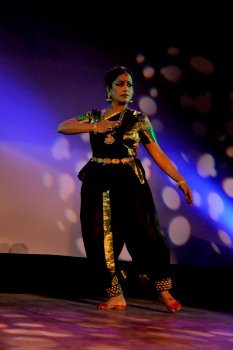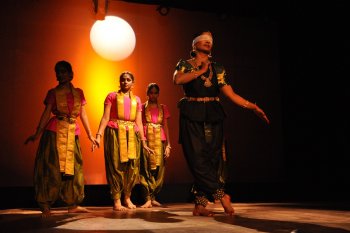
|   |

|   |
Art for life’s sake - Padma Jayaraj e-mail: padmajayaraj@gmail.com February 17, 2014 Vibgyor Film Festival is an alternate international film festival of short films and documentaries, the largest in South Asia, held every year in Thrissur, Kerala. The focus of its ongoing 9th edition is gender justice. The dance drama ‘Gandhari’ staged on the inaugural day of the Vibgyor Film Festival proved to be a befitting curtain raiser giving a mythological dimension to its theme.  Rajeswari Sainath Conceived by the noted poet Vasanth Kannabiran and choreographed by Rajeswari Sainath, the story of Gandhari dismantles patriarchal ideals of pathivrata, dharma, honor, war etc., linking them to greed for power and glory, violence against women and destruction of life. Against a strong musical backdrop provided by flautist B.V. Balasai, the production begins with a prelude that introduces the angle of perception. Narrated in English, the dance drama is interspersed with lyrics in Sanskrit that takes you to Kurukshetra of the Mahabharata where contemporary issues of violence, rape and politics of power reverberate. In Bharatanatyam format the tragic tale of the princess from far away Gandhar unfolds. The chorus introduces the story. Gandhari enters. Gandhari is on trial: the court is her mindscape; her own conscience, the judge. Of course, it is the modern feminist perspective, a review with hindsight, a rethinking. Patriarchy upholds Gandhari as a pathivrata, the dharma of a married woman. She blindfolded herself, forgoing the blessed gift of sight to be an obedient and ideal wife to the blind king Dhritarashtra. The theme of blindness as a metaphor runs through the gamut of the entire drama. Had she provided her gift of sight which her husband lacked, the story would have been different. But how could patriarchy ever replace a king for a queen, even if he is blind! The irony is cast from this point in the story. The second part of the dance drama depicts her pangs for motherhood. Gandhari is a woman personified, wishing for sons to perpetuate the line of the Kurus. Her desire is marred with jealousies for Kunthi who bore sons in the wilderness. In wild rage she delivers a mass of flesh. In spite of hundred sons, somewhere in the corner of her heart lurks the desire for a daughter. A daughter for a mother to love and cherish, despite patriarchy! It is a happy scene in the palace as the children grow up in joy. The dance numbers were vibrant to suit the tempo of childhood and growing up of a number of children in the palace. The third and the final part is the most important segment of this one hour performance. The chorus assumes various roles playing the game. The deceptive nature of power politics symbolized in the game of dice questions the persona of Dharmaputra, the perfect man, the ideal king. His weakness is camouflaged as dharma is the revealing irony here. Gambling leads him from bad to worse as he pawns his kingdom, his brothers and his wife in front of the court of elders of the Kuru dynasty. And violence against women is the culminating point.  In agonizing remorse, Gandhari recalls, “Did my bandaged eyes spare me the sight of proud Draupadi being dragged into the presence of strange men and kings in the court...My son dragging, shaming, stripping, assaulting while the court full of men sat impotent, paralyzed and powerless in the name of dharma....What price for a dharma that demeans and destroys another human being...” And her blindfolded eyes saw the bloody scenes of upcoming war and desolation in the womb of future. The powers that be turning mute, war unleashes atrocities. Destruction perpetuated by man affect everyone stripping away the dignity of humanity. Set on the premise of a battle, the politics and deceit that she witnessed both on and off the battlefield tear at Gandhari’s conscience. Yet, as a woman, she is angry to witness the death of her sons and their sons. The dance performance ends with her understanding of the inevitability of death. From the anger and violence that war envelops, her persona moves to the peace of wilderness in the days of sanyas accompanied by Dhritrashtra and Kunti in the calm environs of the Himalayan wilderness. As a dance drama, the production puts accent on the theme and the dance form is only a suitable format. There is no scope for a scintillating performance. Rajeswari Sainath in the lead role was a controlled actor-dancer. The costume in black suited the somber theme of introspection, and her blind and lonely world. Lighting from an invisible source would have given a tonal quality to the performance. A large screen in the backdrop that projected the mood of the action seemed glaring. Produced by Asmita, the performance was a different experience, something that coalesces the past and the present. Art was used to give an insight. Rajeswari Sainath, a law graduate trained in management, carries rhythm in her genes. As a dancer of 40 years standing, she manages to harmonize nature and nurture as in a symphony. The team work was a success. Being a member of Asmita, she looks at tradition with a question mark. Asmita Resource Center for Women, an NGO based in Hyderabad, is in the forefront of social activism. This group of women is working for socio-economic and political transformation by bridging gender inequalities for the past two decades. Art forms that work at subliminal levels need to be liberated from patriarchal traps. So, one of its many tools is classical dance. Their dance dramas ‘Ahalya’ and ‘Menaka’ attempt a radical thinking in interpreting age-old themes that perpetuate patriarchal norms in a fast changing society. Padma Jayaraj is a freelance writer on the arts and travel. She is a regular contributor to www.narthaki.com |